Any kind of contemporary trend is fuel for a marketer. It is important to know what is getting in and getting out of the global marketing scene. With the knowledge of the content marketing industry, you can plan for an effective and customer-centric content strategy.
As per Gartner’s survey, marketing budget is yet to return to the pre pandemic level causing marketing team across different businesses to face budget crunch.
However, that does not limit stakeholder expectations! So, when the need of the hour is aggressive ROI in a competitive budget – the options get thinner.
Therefore, to target the correct audience effectively, we must isolate the cost effective marketing channels. Going forward, this blog will help you to know the content marketing trends for 2025.
Additionally, you will get information about B2B trends and some examples of highly effective trends in content marketing. Let’s get started.
Content Marketing Trends 2025
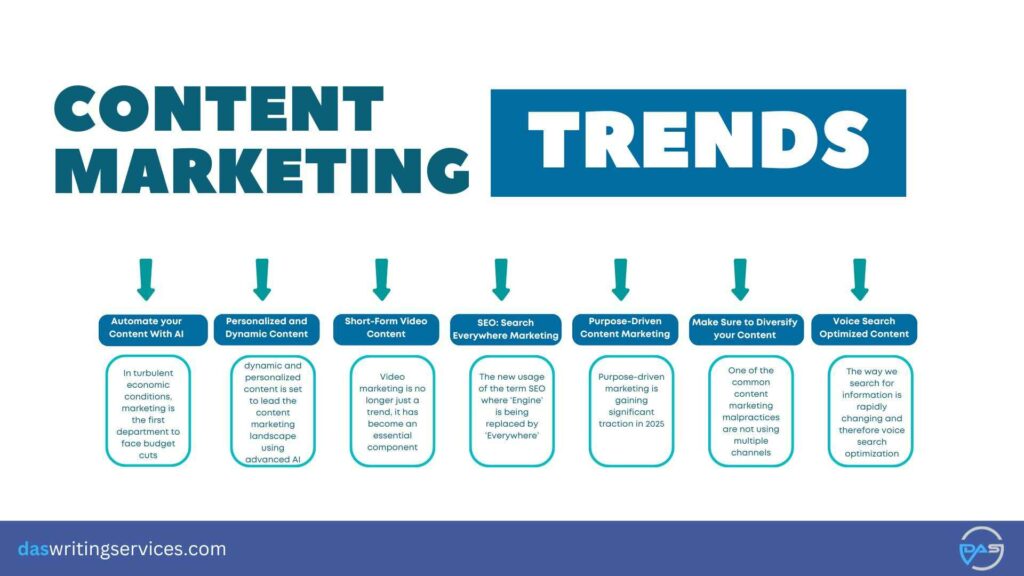
These are some top content marketing strategies in 2025 and beyond:
1. Automate your Content With AI
In turbulent economic conditions, marketing is the first department to face budget cuts. This usually happens with companies that struggle to demonstrate their return on investment (ROI).
To solve this problem, automating the content creation process proves cost effective for businesses. This helps content marketing teams enhance their efficiency by streamlining tasks such as email campaigns and social media marketing communications.
2. Personalized and Dynamic Content
In 2025, dynamic and personalized content is set to lead the content marketing landscape using advanced artificial intelligence (AI) and data analytics. As E-E-A-T continues to remain a vital factor for optimal SERP performance, market leaders can leverage generative AI tools to engage users with personalized messaging and industry expertise.
Implementing these practices ensure the content is not only seen but also gives higher ROI. By integrating real-time personalization into their strategies, marketers can build stronger connections with their audiences. Additionally, this helps to enhance engagement, and drive conversions.
3. Short-Form Video Content
Video marketing is no longer just a trend, it has become an essential component for businesses to engage with customers. Nowadays, most people prefer watching quick, engaging videos over reading lengthy articles.
The demand for different types of video content including how-to guides, and DIY (do it yourself), is at an all-time highest. Because such formats effectively connect with audiences and spark interest in brands.
Statistics reveal that 84% of respondents have converted due to engaging video. Also, 93% of businesses use video on their social media profile by seeing its effectiveness in improving engagement and conversions.
Additionally, generic content is not interesting for your audience. Therefore, this is vital to produce eye-catching, valuable videos that encourage viewers to learn more about your products and services.
4. SEO: Search Everywhere Marketing
The new usage of the term SEO where ‘Engine’ is being replaced by ‘Everywhere’ is catching on among marketers. It stems from the underlying fact that Google SERP continues to integrate SERP features and AI overviews which makes optimizing for Google just not enough.
With new Gen AI tools surfacing every day and alternate search engines like Bing and SearchGPT gaining popularity – traditional SEO optimization is no longer enough to promote a brand to the target group. With a proper balance between on page optimization and social media practices, brands can enhance visibility across different web properties in 2025.
Since, Gen AI tools comb the internet for information, the wider the visibility, the better chances of appearing at places like SERP AIO (AI Overview) and SearchGPT.
5. Purpose-Driven Content Marketing
Purpose-driven marketing is gaining significant traction in 2025. It aligns content marketing efforts with core values that resonate with consumers. In today’s socially connected environment, customers prefer to choose brands that share their values and positively impact society.
This shift requires a strategic change for brands to integrate their values and missions into their marketing campaigns to build deeper connections with customers. By showcasing how your products contribute to a greater good, your brand can attract consumers and build long-term loyalty.
6. Make Sure to Diversify your Content
One of the common content marketing malpractices are not using multiple channels. That is, when one uses mails or on page blog content, most people tend to stick with those only without expanding into other genres.
Using a mix of multiple content types such as webinar, podcasts, e-book, social media post, infographics is essential to target users across multiple platforms and content forms.
Choosing only one or two marketing channels risks losing out on people that prefer other forms of content. So, if you are only writing blogs, you are missing out on the a wide group that consumes mostly podcasts by default.
7. Voice Search Optimized Content
The way we search for information is rapidly changing and therefore voice search optimization leads this evolution. As more consumers adopt voice-enabled devices like virtual assistants, smartphones, and smart speakers, it becomes important for content to be customized to voice queries that generally require a conversational tone.
As a marketer, if you overlook insights from analytics and user behaviour, then your organization is at risk of missing valuable opportunities to enhance content strategies. Thus, you should not neglect data.
Understanding audience search habits is essential to improve content marketing effectiveness. Using data optimization with voice search can boost content performance. By adapting these new search behaviours, your content will stay one step forward in the competitive digital landscape.
B2B Content Marketing Trends
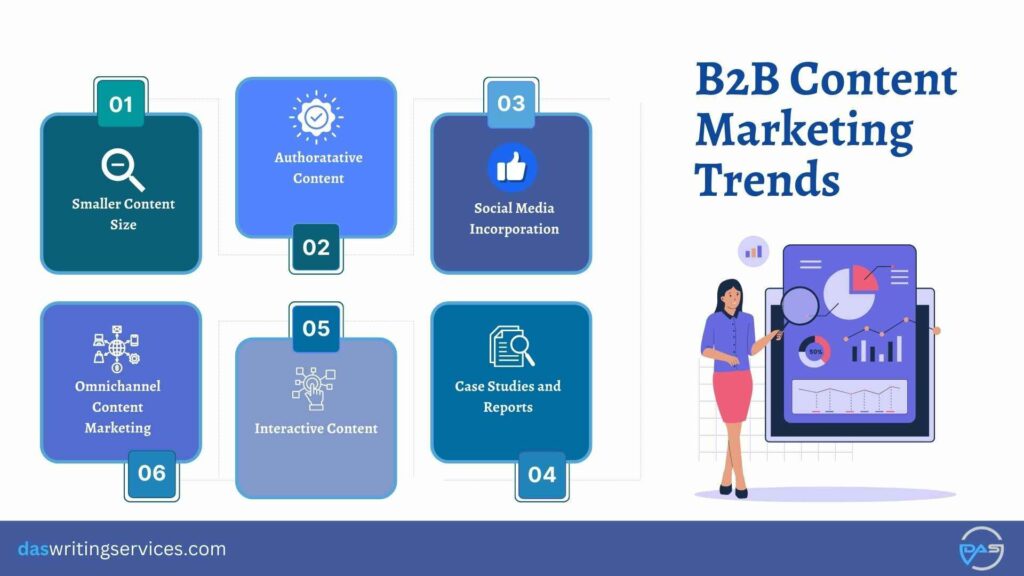
These are some B2B content marketing trends you need to know to stay updated about the current scenario:
1. Smaller Content Size
B2B buyers now generally prefer bite-sized and shorter content such as shooter blogs, e-books, and quick infographics. These types of content effectively deliver information without boring the reader. This trend is supported by the fact that 73% of consumers tend to skim blog posts that indicate a preference for clarity and brevity.
To maintain engagement, you can break complex topics into shorter series rather than lengthy pieces. According to HubSpot’s report, many of their top articles are under 1,500 words. This approach allows readers to consume content quickly and respond directly to the calls to action on the pages.
2. Authoratative Content
B2B buyers are increasingly prioritizing the trustworthiness of information sources. Approximately 78% of B2B buyers follow this factor in their purchasing decisions. To stand out in 2025 and beyond, your company must adopt an authoritative voice in your content. This will also help to position yourself as an expert through thought leadership.
This strategy not only builds trust but also helps brands to effectively connect with their audience. In the B2B landscape, credible and reliable information is extremely important and this can only be delivered with the people experienced in the field.
3. Social Media Incorporation
According to recent statistics, 92% of B2B content marketers use social media for content distribution. In this scenario, LinkedIn is leading the position for B2B content marketing. Other platforms like Facebook, Instagram, and Twitter are also showing potential for generating quality results. WhatsApp ads are being used mainly for B2C content marketing.
This trend matches with the growing interest for short-form content across buyers. People prefer to check quick but helpful and relevant insights via social media rather than lengthy articles.
The shift shows that there is a broader change in content consumption habits where smaller and more engaging posts are being favoured for their efficiency in delivering valuable information.
4. Case Studies and Reports
B2B buyers generally prefer checking case studies or reports before making a purchase. Nowadays, case studies are getting more preference than customer testimonials. From case studies, a buyer can get detailed information about how your services worked for your existing client.
If you are targeting a B2B audience to sell your products or services, therefore, you must have your report and case studies available. This is also helpful for your business team to showcase your expertise in the field.
Do you have some well-recognized and reputed brands in your client portfolio? Prepare some case studies of the collaborations and use them as content that helps you to sell faster.
5. Interactive Content
In 2025, people will still use information from AI tools but what if your website has the same information on your website. Yes! You can take help from AI to make your repetitive work easier but your content must be interactive. There are many websites present on the internet to solve the same query or sell the same product.
Additionally, you need to incorporate some interactive sections with your content so that they spend more time with your content. To create authority in front of Google and the audience, your content should engage them. Some of the interactive content are:
- Videos
- Animations (like data visualizations for infographics)
- Interactive e-books
- Multi-touch images and video
- Quizzes
- Polls
- Calculators
Using this type of interactive content, you can turn your passive content into an active one. This type of content gets more likes, shares and comments which is good for SEO and improving brand image.
6. Omnichannel Content Marketing
Omnichannel marketing is a customer-centric content marketing strategy that integrates all channels both physical and digital. The main focus is to provide a unified and consistent brand experience across various touchpoints such as in-store, apps, and websites.
This approach ensures that customers can seamlessly interact with the brand and enhance their overall experience throughout the customer journey. By focusing on every customer touchpoint, omnichannel strategies aim to create a cohesive experience that connects all interactions. Collectively, this strategy helps to improve the engagement and satisfaction of your B2B audience.
Content Marketing Trends Examples
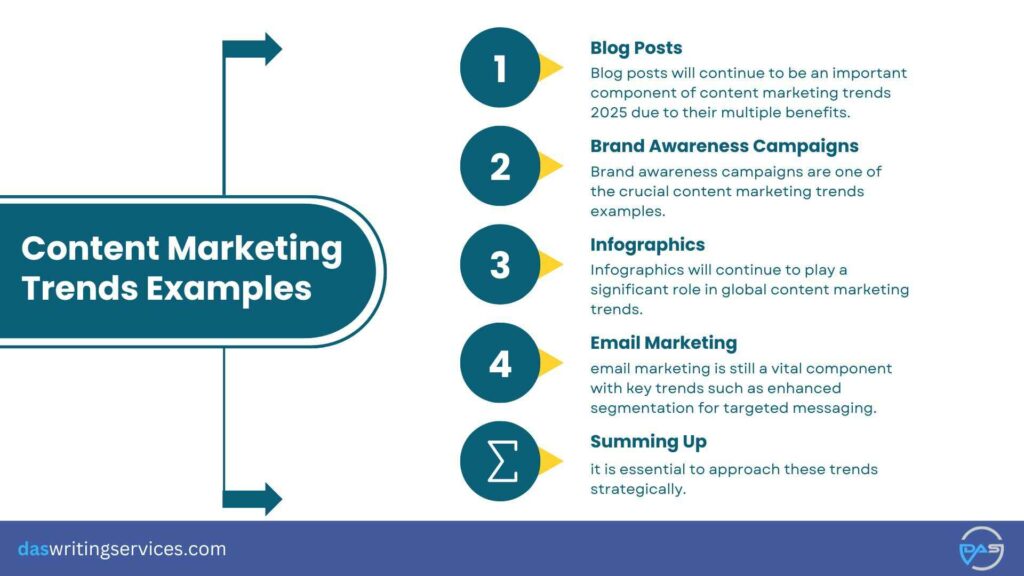
These are some top trending content marketing examples which will be in focus in 2025 and even beyond:
1. Blog Posts
Blog posts will continue to be an important component of content marketing trends 2025 due to their multiple benefits. This is one of the best SEO content marketing that enhances the SEO of a website and attracts organic leads. Blog posts engage potential customers by providing valuable, helpful and customer-centric information to help them make informed decisions.
By posting informative and well-crafted content, blog posts can help your brand to position itself as a thought leader. Additionally, it helps in building trust, brand reputation and customer loyalty.
To make your blogs effective, you need to follow the latest content marketing trends such as posting long-form content, search engine optimization, and engaging visuals (images, infographics, etc.) throughout the page.
2. Brand Awareness Campaigns
Brand awareness campaigns are one of the crucial content marketing trends examples that enhance the recognition and visibility of a brand. This will remain an effective content marketing trend in 2025 due to its ability to connect with audiences across various platforms. Successful brand awareness campaigns generally utilize innovative strategies that build emotional connections with consumers.
For example, Coca-Cola’s “Share a Coke,” campaign which personalized products to foster sharing and connection. In this campaign, the traditional Coca-Cola logo on bottles was replaced with popular names. Thus, Coca-Cola encourages their consumers to find and share a Coke with friends, family, and even strangers.
By focusing on creativity, emotional engagement, and strategic use of digital platforms, brand awareness campaigns will continue to thrive and evolve in the landscape of content marketing trends 2025.
3. Infographics
Infographics will continue to play a significant role in global content marketing trends due to their ability to enhance engagement and express especially complex information visually. Infographics are used to summarize blogs, share statistics, and clarify technical processes.
It adds visual interest that can attract more engagements, organic links, and shares than other formats. Therefore, it can be considered an effective tool for capturing the audience’s attention.
You can easily create infographics using different AI tools that will also save you time effectively. Thus, you can also scale and streamline the designing process of high-quality visuals that resonate with your target audience.
In short, by using infographics creatively and strategically, you can enhance your content marketing efforts and maintain relevance in the evolving content marketing trends 2025.
4. Email Marketing
As we enter 2025, content marketing trends are changing due to AI integration, personalization, interactive content, video content, and community engagement. However, email marketing is still a vital component with key trends such as enhanced segmentation for targeted messaging.
Additionally, AI automation is streamlining communication through timely and relevant messages. Together, these trends highlight the importance of using technology and delivering meaningful experiences to build customer loyalty and drive engagement in the evolving digital marketing trends in 2025. To know more about different content marketing examples, you may check our blog on this topic.
Summing Up
Content marketing trends are extremely important for creating relevant and engaging content that captures the attention in a crowded digital landscape. However, it is essential to approach these trends strategically. If you blindly follow every trend, it can result in irrelevant content that derails brand image, values, and audience interests.
By identifying and creatively integrating trends that match both the brand and its audience (for example, hyper-personalization, video content, and interactive elements), marketers can enhance content visibility and effectiveness.
Frequently Asked Questions
1. What are the key content marketing trends for 2025?
Key trends for 2025 are AI integration to scale content creation, hyper-personalization of content, and a focus on human-centric storytelling that builds emotional connection with audiences. Brands will also prioritize interactive content and voice search optimization to improve engagement and accessibility.
2. How is AI influencing content marketing in 2025?
In 2025, AI will play a crucial role in supporting content creation by providing insights and data analysis. This allows content marketers to create more relevant and personalized content. However, AI tools can be used to reduce work pressure not to replace human creativity and storytelling.
3. What does hyper-personalization mean in the context of content marketing?
Hyper-personalization refers to content customization to meet specific needs, behaviours, and preferences of individual users in real time. In this trend, you can expect enhanced engagement and conversion rates. Thus, it is a vital strategy for B2B content marketing in 2025.
4. What are some examples of new trends in content marketing?
Examples of new trends include the shift towards aspirations-driven content that aligns with customer values, the use of smaller videos, and the use of interactive elements like polls and quizzes to boost user engagement.
5. How should brands adapt their strategies to align with global content marketing trends?
Brands should focus on creating authentic, insights-driven content that builds trust and connections with the audience. Additionally, they should use data analytics to inform their strategies and ensure that their content remains relevant to evolving consumer expectations.
6. What future trends can we expect in B2B content marketing?
Future trends in B2B content marketing will include increased dependence on AI for automation, storytelling concepts to create emotional connections with business audiences, and interactive components such as podcasts and short-form videos to engage users effectively.
Subhodip Das is the founder and CEO of Das Writing Services Pvt. Ltd. He has an experience of 12 years in the field of Digital Marketing and specialises in Content Writing and Marketing Strategies. He has worked with well-established organisations and startups helping them achieve increased Search Engine Rank visibility. If you want to grow your business online, you can reach out to him here.

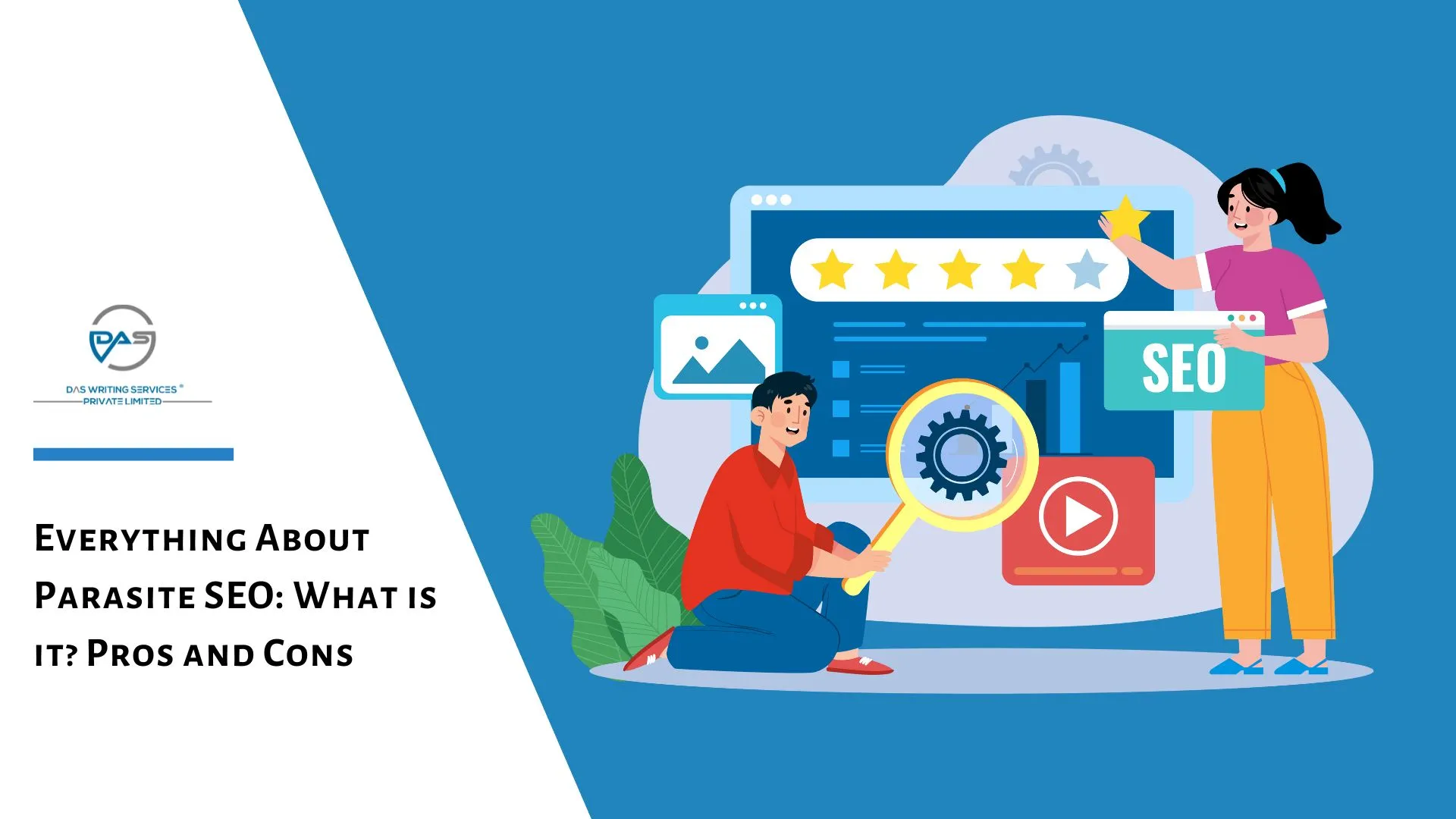
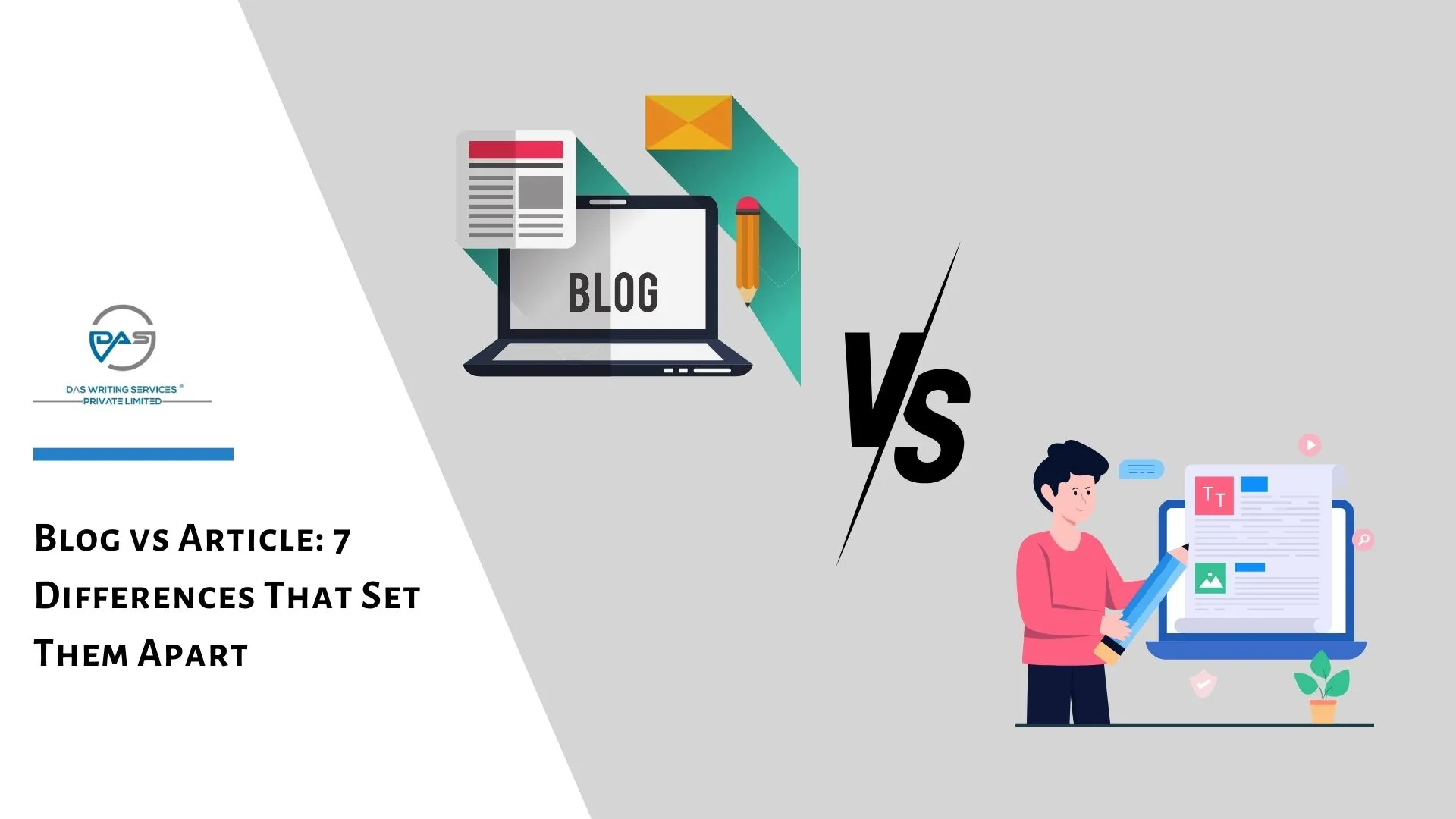

Leave a comment